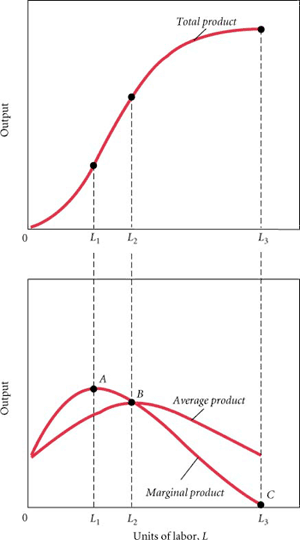Diminishing returns
| Economics |
|---|
_Per_Capita_in_2015.svg.png) |
|
|
| By application |
|
| Lists |
|
In economics, diminishing returns is the decrease in the marginal (incremental) output of a production process as the amount of a single factor of production is incrementally increased, while the amounts of all other factors of production stay constant.
The law of diminishing returns states that in all productive processes, adding more of one factor of production, while holding all others constant ("ceteris paribus"), will at some point yield lower incremental per-unit returns.[1] The law of diminishing returns does not imply that adding more of a factor will decrease the total production, a condition known as negative returns, though in fact this is common.
A common sort of example is adding more people to a job, or assembling a car on a factory floor. At some point, adding more workers causes problems such as workers getting in each other's way or frequently finding themselves waiting for access to a part. In all of these processes, producing one more unit of output per unit of time will eventually cost increasingly more, due to inputs being used less and less effectively.[2]
The law of diminishing returns is a fundamental principle of economics.[1] It plays a central role in production theory.[3]
History
The concept of diminishing returns can be traced back to the concerns of early economists such as Johann Heinrich von Thünen, Jacques Turgot, Adam Smith,[4] James Steuart, Thomas Robert Malthus and David Ricardo. However, classical economists such as Malthus and Ricardo attributed the successive diminishment of output to the decreasing quality of the inputs. Neoclassical economists assume that each "unit" of labor is identical. Diminishing returns are due to the disruption of the entire productive process as additional units of labor are added to a fixed amount of capital. The law of diminishing returns remains an important consideration in farming.
Diminishing marginal returns

The defining feature of diminishing marginal returns is that as total investment increases, the total return on investment as a proportion of the total investment (the average product or return) decreases. Suppose, for example, that 1 kilogram of seed applied to a certain plot of land produces one ton of crop, that 2 kg of seed produces 1.5 tons, and that 3 kg of seed produces 1.75 tons. In formulaic terms, the th kg of seeds produces additional tons of crop. The return from investing the first kilogram is 1 t/kg. When 2 kg of seed is invested, the return is 1.5/2 = 0.75 t/kg, and when 3 kg is invested, the return is 1.75/3 = 0.58 t/kg.
In formulaic terms, for this example, the diminished marginal return is:
where = seed in kilograms, and = additional crop yield in tons, for the th kilogram of seed.
Substituting 3 for and expanding yields:
Another example is a factory that has a fixed stock of capital, or tools and machines, and a variable supply of labor. As the firm increases the number of workers, the total output of the firm grows but at an ever-decreasing rate. This is because after a certain point, the factory becomes overcrowded and workers begin to form lines to use the machines. The long-run solution to this problem is to increase the stock of capital, that is, to buy more machines and to build more factories.
Returns and costs
There is an inverse relationship between returns of inputs and the cost of production. Suppose that a kilogram of seed costs one dollar, and this price does not change. Although there are other costs, assume they do not vary with the amount of output and are therefore fixed costs. One kilogram of seeds yields one ton of crop, so the first ton of the crop costs one dollar to produce. That is, for the first ton of output, the marginal cost of the output is $1 per ton. If there are no other changes, then if the second kilogram of seeds applied to land produces only half the output of the first, the marginal cost would equal $1 per half ton of output, or $2 per ton. Similarly, if the third kilogram of seeds yields only a quarter ton, then the marginal cost equals $1 per quarter ton, or $4 per ton. Thus, diminishing marginal returns imply increasing marginal costs and rising average costs.
Cost can also be measured in terms of opportunity cost. In this case the law also applies to societies – the opportunity cost of producing a single unit of a good generally increases as a society attempts to produce more of that good. This explains the bowed-out shape of the production possibilities frontier.
See also
- Diminishing marginal utility, also not to be mistaken for 'diminishing returns'
- Diseconomies of scale, does not assume fixed inputs, thus differing from 'diminishing returns'
- Economies of scale
- Increasing returns
- Learning curve and Experience curve effects
- Marginal value theorem
- Opportunity cost
- Pareto principle
- Submodular set function
- Tendency of the rate of profit to fall
- Liebig's Law of the minimum
References
- 1 2 Samuelson, Paul A.; Nordhaus, William D. (2001). Microeconomics (17th ed.). McGraw-Hill. p. 110. ISBN 0071180664.
- ↑ George, Henry. The Science of Political Economy. New York: Robert Schalkenbach Foundation.
- ↑ Encyclopedia Britannica. Encyclopædia Britannica, Inc. 26 Jan 2013. ISBN 9781593392925.
- ↑ Smith, Adam. The wealth of nations. Thrifty books. ISBN 9780786514854.
Sources
- Case, Karl E.; Fair, Ray C. (1999). Principles of Economics (5th ed.). Prentice-Hall. ISBN 0-13-961905-4.